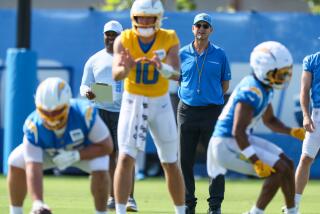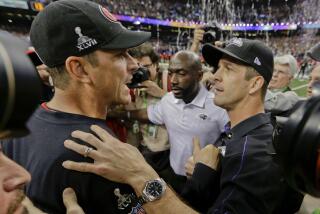Bart Starrâs significance in Green Bay continues well after his career
From New London, Wis. â At Lambeau Field in Green Bay, you wonât uncover the full measure of Bart Starrâs extraordinary legacy.
To bring into focus a more vivid picture of this gracious, benevolent man youâll need to look beyond the Hall of Fame career with the Green Bay Packers, the nerveless leadership and the championships won under Vince Lombardi.
Youâll need, perhaps, to drive about an hour west of Green Bay to a wooded oasis known as the Rawhide Boys Ranch.
Co-founded by Starr, wife Cherry and a similarly generous couple, John and Jan Gillespie, Rawhide for 45 years has reshaped the lives of thousands of troubled young men.
Starr, 76, helped put Rawhide on the map at the height of his Packers popularity in 1968, when he donated the red Corvette Stingray convertible heâd won as the most valuable player in Super Bowl II. The resulting raffle generated invaluable publicity for the ranch and a major financial windfall for its preservation.
Nearly five decades later, the NFL icon remains an active spokesman, fundraiser and inspiration.
âIâm thrilled and honored to have been a member of the Green Bay Packers,â Starr says from his office in Birmingham, Ala., âbut on another plateau is the Rawhide Boys Ranch because of what it has meant ⦠to so many youngsters who need this type of facility to change, grow, mature and expand their lives.â
John Solberg, Rawhideâs executive director, says Starrâs commitment equates to about $1 million a year.
âRawhide,â Solberg tells a visitor to the 576-acre property hard by the Wolf River in central Wisconsin, âwould not be what it is today without Bart and Cherryâs involvement.â
Starr modestly calls his commitment âa privilege.â
Heâs grateful for the hopeful naivete of Jan Gillespie, who in 1966 harangued her husband into cold-calling the Packers quarterback, insisting that Starrâs phone number in Green Bay might actually be listed in the directory.
Never mind that Starr at that time was perhaps the best-known player on the NFLâs most prominent team.
A 17th-round draft pick from Alabama in 1956, Starr had found an ally in Lombardi, who discovered that he could rely on the quarterbackâs intelligence and leadership abilities.
Together, they won five championships in seven seasons, Starr honored as MVP of the first two Super Bowls.
Meanwhile, Gillespie realized he needed a partner to help him fulfill his dream of aiding wayward youth. Through the grapevine, he heard that Starr and his wife were like-minded in their concern for at-risk teens and might be willing to get involved.
But, he notes, âBart was very, very popular at that time. I was trying to find somebody that could introduce me and Jan said, âWhy donât you just call him?â I said, âYou canât do that.ââ
Actually, you could.
Finding that Starrâs number was listed, Gillespie called and asked whether they could meet.
They met that night, Starr and his wife inviting the Gillespies to dinner at their home in Green Bay. After only about a 10-minute pitch, Gillespie says, the quarterback was sold.
Starr says he was intrigued by the projectâs enormous potential.
âJohn and Jan did a marvelous job of telling us what their hopes and dreams were, and my wife and I were just overwhelmed by it,â he says. âI donât think that we as adults can do anything more important than helping youngsters in need.â
Two years later, Rawhide was still struggling to make ends meet when Starr and his wife proposed raffling the car.
Raffles were illegal in Wisconsin at that time, Gillespie says, so Rawhide had to get a special dispensation from then-Gov. Warren P. Knowles, who of course was a Packers fan.
With tickets priced at $1 â a Corvette Stingray convertible at that time sold for about $4,300 â the raffle raised $65,000.
âIt was astronomical,â Gillespie says, noting that the proceeds nearly matched the cost of the property. âThat got Rawhide on its feet. The finances were under control after that.â (The car, locally owned, is returned to Rawhide for special events.)
Starrâs involvement, however, did not end there.
His fees for speaking engagements and card-show appearances are donated to Rawhide, which houses the court-appointed teens for stretches of four months to two years and has enriched the lives of about 3,000 youth through a program focused on academics, work experience and faith-based moral training.
âThe work they do really is life-changing,â says Ryan Keshemberg of Madison, Wis., a financial advisor who as a teen spent four months at Rawhide. âIt makes a difference.â
As was its foundersâ hope.
Says Gillespie, âWe really believe that if our hearts are right, God intervenes ⦠and we just feel this was a God thing that put Bart and Cherry and Jan and I together.â
Starr and his wife, who in 1988 lost a son due to complications related to drug addiction, still make frequent visits to the ranch, which has expanded to include seven youth homes.
âItâs such a thrill to see what has grown and developed over the years,â the Packers legend says. âWe had a reunion a few years ago and a number of the youngsters who came back were officers in the military. We were in the field house, listening to their stories, and there was not a dry eye in the house.â
He vows to stay involved.
âWe canât ever do enough,â he says.
More to Read
Go beyond the scoreboard
Get the latest on L.A.'s teams in the daily Sports Report newsletter.
You may occasionally receive promotional content from the Los Angeles Times.










